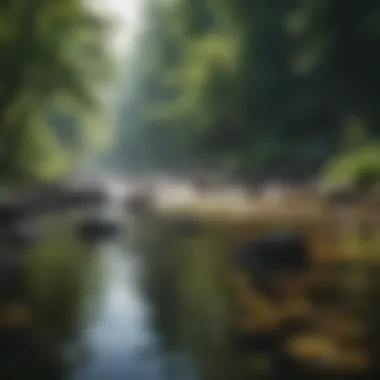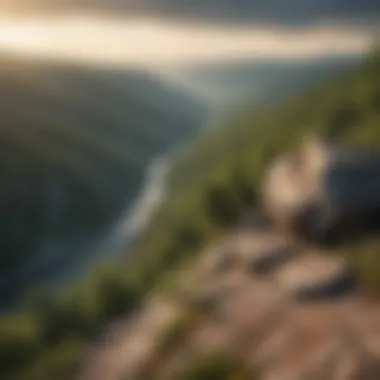Discovering the Scenic Wonders of West Virginia


Intro
West Virginia is often overlooked, yet it holds an impressive array of scenic spots. This state is characterized by its diverse landscapes, including towering mountains, lush forests, and flowing rivers. Not only do these elements contribute to aesthetic beauty, they also create a rich environment for various outdoor activities.
From hiking trails in the Appalachian Mountains to serene rivers perfect for kayaking, outdoor enthusiasts will find much to explore.
West Virginia's natural offerings are not just visually appealing; they hold cultural significance and provide a habitat for various wildlife species. These elements together paint a picture of what makes West Virginia unique.
Key Attractions
Blackwater Falls State Park
Blackwater Falls is known for its stunning waterfall, which tumbles 62 feet into the Blackwater River. The park offers hiking trails and viewpoints that enhance the experience of this natural wonder.
New River Gorge National Park
As a location renowned for its whitewater rafting, New River Gorge is a prime spot for adventure. The extensive gorge and its diverse plant life make it a perfect destination for both thrill-seekers and nature lovers.
Seneca Rocks
Seneca Rocks offers a unique climbing experience. The towering rock faces present both a challenge and a visual treat. Visitors can hike to the summit for panoramic views.
Closure
Preface to West Virginia's Landscape
West Virginia is more than just a state; it is a canvas of natural beauty painted with diverse landscapes. This section provides a foundation for understanding the unique characteristics of West Virginia's scenery, emphasizing the importance of its geographical and climatic conditions. Appreciating these factors is crucial for anyone keen to explore the state, as they shape not only the visual appeal but also the recreational opportunities available.
Geographical Overview
West Virginia is known for its rugged terrain, characterized by the Appalachian Mountains that run through the state. The elevation varies significantly, with peaks reaching over 4,800 feet, providing stunning vistas and a variety of ecosystems. The state is framed by captivating rivers, including the Potomac and Kanawha, which carve through valleys, creating pathways for adventure seekers and nature enthusiasts. Other notable features include the numerous state parks and national forests that preserve vast stretches of wilderness, showcasing everything from expansive meadows to dense woodlands.
Several geographical components make West Virginia unique:
- Mountain Ranges: The Allegheny and Appalachian ranges dominate the landscape, influencing weather patterns and biodiversity.
- Rivers and Lakes: Water bodies serve as recreational hubs, enriching both the natural scenery and local economies.
- Forested Areas: Approximately 75% of West Virginia is covered in forests, home to diverse wildlife and plants.
These features facilitate a rich array of activities from hiking to rafting, making the state an attractive destination for outdoor lovers.
Climate Influences on Scenery
The climate in West Virginia is varied, with cool winters and warm summers, which greatly contribute to the aesthetic appeal of its landscapes. The average temperature ranges from 20°F in winter to 78°F in summer, resulting in diverse seasonal changes.
- Seasonal Variety: Each season transforms the scenery, from lush greens in summer to vibrant autumn colors, which are a significant draw for visitors.
- Precipitation Patterns: The state receives ample rainfall, supporting diverse ecosystems and healthy waterways.
- Microclimates: Elevation differences create varied microclimates, allowing for a wide range of flora and fauna, enhancing the state’s biodiversity.
“The climate not only affects how the landscape looks but also determines what activities are feasible and when to engage in them.”
Awareness of these climatic factors is essential for planning visits and exploring the scenic diversity West Virginia has to offer.
Parks and Nature Reserves
Parks and nature reserves play a crucial role in showcasing West Virginia's natural beauty and preserving its ecological diversity. The state's vast landscapes, ranging from rolling hills to rugged mountains, provide a habitat for numerous species. These protected spaces offer more than just stunning views; they are vital for conservation efforts and serve as outdoor recreation areas for visitors. The parks foster a connection between people and nature, enabling educational experiences and promoting environmental awareness.
New River Gorge National Park
Overview and Significance
New River Gorge National Park is a standout location in West Virginia, renowned for its geological features and ecological significance. The park encompasses a deep gorge carved by the New River, showcasing dramatic cliffs and a rich diversity of flora and fauna. It acts as a prime example of natural erosion processes and serves as a habitat for endangered species. The unique landscape coupled with recreational opportunities makes it a popular destination for both tourists and locals.
Activities and Attractions
Visitors to New River Gorge can partake in a wide range of activities, making it a multifaceted destination. Adventurous individuals can explore white-water rafting, rock climbing, and hiking trails that span across several miles. Each activity presents unique opportunities to appreciate the environment. Additionally, the availability of guided tours enriches the visitor experience, allowing for both education and adventure in one package.
Cultural Heritage


New River Gorge is also significant from a cultural and historical perspective. The area is deeply entwined with American history, particularly in terms of coal mining and the impact on local communities. Numerous historic sites and structures provide insight into the cultural evolution of the region. This blending of natural and cultural heritage offers visitors a comprehensive understanding of West Virginia's identity.
Blackwater Falls State Park
Waterfall Features
Blackwater Falls State Park is home to one of the tallest waterfalls in West Virginia. The stunning vistas with cascades tumbling over dark brown rocks present a picturesque sight. These features are a highlight for photographers and nature enthusiasts alike. The distinct color of the water, tinted by the tannins from the surrounding vegetation, creates a unique aesthetic appreciated by many.
Hiking Trails
Blackwater Falls boasts numerous hiking trails suitable for varying skill levels. These trails lead through diverse landscapes, allowing hikers to explore lush forests and reach scenic overlooks. Each trail offers opportunities to see the park’s rich biodiversity, including native plants and wildlife. The extensive trail system encourages exploration but may require preparation due to fluctuating terrain and weather conditions.
Wildlife Observation
The park is teeming with wildlife, making it a prime location for observation. Bird watchers can look for a variety of species, while other animals can be seen in their natural habitats. The seasonal changes in the park bring different wildlife activity, providing unique opportunities for visitors throughout the year. This aspect enhances the overall experience for wildlife enthusiasts, making it a popular choice for nature lovers.
Seneca Rocks Recreation Area
Rock Climbing Opportunities
Seneca Rocks is well-known for its impressive rock formations, attracting climbers from all over. The challenging climbs offer an adrenaline rush as well as a chance to connect with nature. The area provides various routes for different skill levels, making it accessible for both beginners and experienced climbers. The unique geological features present a thrilling challenge and a well-respected destination in the climbing community.
Scenic Views
The views from Seneca Rocks are breathtaking, with dramatic vistas showcasing the expansive landscape of West Virginia. Visitors can appreciate the beauty from several viewpoints, encouraging photography and sightseeing. These panoramic vistas are a prominent characteristic of the area, making it an essential stop for any visitor.
Visitor Information
Understanding the visitor protocols and available amenities is vital for a good experience at Seneca Rocks. The park provides resources for climbing safety, including guidelines and gear rentals. Detailed maps and information encourage exploration while ensuring the safety of all visitors. Knowing this information can help in planning visits to make the most out of the secured activities offered within the recreation area.
Rivers and Waterfalls
Rivers and waterfalls hold a significant place in understanding the beauty of West Virginia. These natural features not only enhance the landscape but also offer numerous recreational activities for visitors. The flow of water through valleys creates a serene atmosphere. Furthermore, these bodies of water serve as vital ecosystems that support wildlife and plant life. Exploring rivers and waterfalls can lead to a deeper appreciation of nature.
The Potomac River
Riverside Activities
Riverside activities along the Potomac River are an essential part of the experience. Common activities include fishing, kayaking, and picnicking. These activities encourage people to engage with the natural environment. Kayaking, in particular, is popular due to the calm waters in certain sections of the river. This allows for a peaceful experience amidst beautiful scenery. However, safety precautions must be taken, such as wearing life jackets and being aware of weather conditions.
Scenic Drives
Scenic drives near the Potomac River provide a perfect opportunity to admire the surroundings. The winding roads along the river offer stunning views of the water and adjacent hills. These drives are beneficial for those who prefer not to partake in water activities. They allow for leisurely exploration of the region's beauty. Nevertheless, it can be challenging to find parking at peak times, especially during weekends.
Historical Significance
The historical significance of the Potomac River adds depth to its appeal. The river played a crucial role during early American history. It served as a vital transport route. Landmarks along the river tell stories of past events, making it a compelling destination for history enthusiasts. This aspect draws attention to the cultural heritage of West Virginia. However, busy tourist areas often overshadow quieter historical sites, leading to under-appreciation of less frequented locations.
Shay's Rebellion Falls
Unique Geographical Features
Shay's Rebellion Falls showcases unique geographical features that attract nature lovers. The falls are characterized by steep cliffs and distinctive rock formations. This creates a visually striking environment. The combination of flowing water and rugged terrain adds to its allure. Visitors often appreciate the diverse ecosystems surrounding the falls. However, accessibility can be limited due to steep trails leading to the viewing areas.
Access Points
Access points to Shay's Rebellion Falls make visiting the site manageable. Main trails provide clear directions to viewpoints, ensuring safety for all types of hikers. Notably, some paths are less traveled, offering solitude amidst nature. This can be appealing for those who seek a more private experience. Despite this, the main access point may be crowded during peak seasons, potentially diminishing the experience for some.
Photography Tips
Photography tips for capturing Shay's Rebellion Falls can enhance the experience for visitors. Early mornings or late afternoons provide the best light for photography, highlighting water features beautifully. Using a tripod can help stabilize shots, especially in lower light conditions. Furthermore, framing the falls with surrounding foliage can create a captivating image. However, it is essential to remain mindful of regulations regarding flash photography in wildlife-sensitive areas.
Mountains and Vistas
The mountains and vistas of West Virginia create a vital connection to the state's natural beauty. These elevations attract hikers, adventurers, and nature enthusiasts alike. They offer unique landscapes that showcase the diverse features of this region. The mountains are not just visually stunning but also serve ecological functions that are essential for the environment. By exploring these areas, visitors can appreciate the significance of West Virginia's mountainous terrain and its effect on the local ecosystem.


Appalachian Mountains
Elevation and Terrain
West Virginia is characterized by the impressive Appalachian Mountains. The elevation varies greatly, ranging from 1,500 feet in the valleys to over 4,800 feet at the peaks. This elevation contributes significantly to the diverse terrain found in the region. Higher areas often feature rugged ridges and steep inclines that challenge even experienced hikers. The terrain has rocky outcrops and dense forests that are important for natural wildlife habitats.
One key characteristic of the terrain is its ability to support a variety of recreational activities, such as hiking, climbing, and camping. Visitors can explore numerous trails that provide breathtaking views. However, these activities can also create environmental concerns, including soil erosion and habitat disruption. Ensuring that visitors practice responsible outdoor ethics is essential.
Flora and Fauna
The flora and fauna in the Appalachian region are notable for their richness and diversity. This area houses a variety of plants, including deciduous trees, wildflowers, and ferns, all supported by its unique elevation and climate. Different ecological zones exist within the mountains, which contribute to varying plant species at different altitudes.
This characteristic makes the area popular for nature lovers. Bird watchers and botanists often visit to observe the rare species. However, the delicate balance of these ecosystems can be affected by human activity like logging and pollution. Protecting these natural habitats is crucial for preserving this diversity.
Seasonal Changes
Seasonal changes in the Appalachian Mountains significantly impact the landscape. In autumn, the foliage turns vibrant shades of red, orange, and yellow, attracting photographers and visitors. Spring brings blooming wildflowers and rejuvenation of the landscape, while summer offers lush green vistas.
Winter transforms the mountains into a white wonderland. This characteristic makes the region popular for various activities. However, the drastic weather changes can present challenges, including icy conditions that make hiking unsafe. Understanding these seasonal changes helps visitors plan their trips effectively.
Chairback Mountain
Access Routes
Access routes to Chairback Mountain vary, with main trails leading to the summit being popular among hikers. The well-marked pathways provide options for different skill levels, allowing more people to explore this stunning location. Each route offers distinct views and experiences, making them a key feature for visitors seeking exploration.
However, not all trails are equally maintained. Some paths may have rougher terrain that can pose risks. It's important for hikers to be aware of their chosen route and prepare accordingly.
Spectacular Overlooks
Chairback Mountain boasts several spectacular overlooks that offer panoramic views of the surrounding landscape. Standing at these vantage points provides a sense of being part of nature's grandeur. The unique placement of these overlooks allows visitors to capture remarkable photographs. These spots have become popular, often appearing in social media posts and travel guides.
While the views are breathtaking, the high traffic can sometimes lead to environmental degradation. Responsible visitation practices are essential in preserving the beauty of these overlooks for future generations.
Conservation Efforts
Conservation efforts in the Chairback Mountain area focus on maintaining the ecological balance and preserving the natural beauty. Organizations and local communities work together to manage resources and protect wildlife habitats. Raising awareness about the importance of these efforts is critical to securing support from visitors and locals.
Unique features of these conservation efforts include clean-up events and educational programs for community involvement. Yet, funding and commitment can be inconsistent. Continued advocacy for these efforts is vital in ensuring the protection of Chairback Mountain's natural resources.
Cultural and Historical Sites
Cultural and historical sites in West Virginia offer a lens into the past that complements its natural beauty. These locations provide more than just visual appeal; they hold stories that shape the identity of the state. By incorporating both history and culture into the exploration of scenic areas, visitors gain a deeper appreciation for West Virginia's multifaceted character.
Historic Harpers Ferry
Significance in American History
Harpers Ferry holds a prominent place in American history, particularly during the Civil War era. The site was a key strategic point due to its location at the confluence of the Potomac and Shenandoah Rivers. John Brown's raid in 1859, aimed at initiating a slave revolt, showcased the tensions leading to the Civil War. This historical backdrop makes Harpers Ferry a significant attraction. Visitors can see firsthand how this small town influenced larger events in American history.
Natural Beauty
Beyond its historical significance, Harpers Ferry also captivates with its natural beauty. The surrounding hills and rivers provide stunning views and excellent opportunities for photography. The sharp contrast between the heights and the waterways enhances the scenic quality of the area. This blend of nature and history makes Harpers Ferry a favored destination for those seeking beauty alongside educational experiences.
Visitor Attractions
Harpers Ferry offers various attractions that cater to different interests. From museums dedicated to the Civil War to historical reenactments, there’s much to explore. The Appalachian Trail, which runs through the area, is popular with hikers seeking a mix of recreation and history. The accessibility of these attractions adds to the overall appeal, making it easy for visitors to engage with the site’s significance.
The Trans-Allegheny Lunatic Asylum
Architectural Highlights
The Trans-Allegheny Lunatic Asylum is notable for its Gothic architecture and massive scale. Constructed in the mid-19th century, it reflects the design concepts of that era. The asylum's stone walls and intricate details provide a glimpse into the architectural styles of the time. This building's historical context offers insights into the treatment of mental health and its evolution through the years. Its preservation allows for meaningful exploration of these themes, drawing visitors interested in architecture and history alike.


Cultural Context
The asylum carries a significant cultural context as it was once a center for mental health care in America. Understanding its role reveals attitudes towards mental health from the 19th century to now. Visitors can learn about the societal implications and the changes in psychiatric care over the years. This aspect deeply enriches the visitor experience and serves as a reminder of the progress made in mental health awareness.
Scenic Surroundings
Situated on a sprawling estate, the Trans-Allegheny Lunatic Asylum is enveloped in natural beauty. The lush grounds and surrounding landscapes complement the historical architecture. This intersection of history and nature enhances the site's visitation appeal. Visitors can engage in guided tours that showcase both the asylum and its scenic backdrop, making it a comprehensive attraction.
Historical and cultural sites provide essential context to the scenic views in West Virginia, enabling deeper engagement with the state’s heritage.
Seasonal Attractions
Seasonal attractions offer a dynamic dimension to West Virginia's already diverse scenic beauty. The state's geography, climate, and cultural activities change with the seasons, creating unique experiences for visitors year-round. In autumn, vibrant foliage enchants nature lovers, while winter transforms the region into a snowy paradise for sports enthusiasts. Both seasons provide unique opportunities to engage in outdoor activities and celebrate local traditions.
Autumn Foliage
Best Viewing Locations
West Virginia boasts some of the most breathtaking spots for viewing autumn foliage. The serene landscapes of the Monongahela National Forest stand out as prime locations. Here, the hues of red, orange, and yellow create stunning contrasts against the green pines. Locations such as Spruce Knob provide high vantage points, offering expansive views of rolling hills adorned with colorful leaves.
These locations are beneficial for finding the most striking autumn scenes. They are popular among photographers and nature enthusiasts. While exploring these areas, visitors should consider timing, as peak foliage lasts only a short period. Finding vantage points may require some hiking or driving along scenic routes, adding to the overall experience.
Photography Opportunities
Autumn in West Virginia presents exceptional photography opportunities. The changing leaves create a canvas that seems to shift with the light throughout the day. Popular spots like Blackwater Falls serve as great backdrops, where cascading water meets vibrant foliage. A balance of reflectivity in water bodies enhances photo composition.
The landscapes offer photographers a chance to capture seasonal change in various forms. However, it can be crowded during peak season, which may affect the ease of capturing tranquil images. Additionally, weather can change quickly, influencing lighting conditions. Therefore, having flexible plans is advisable.
Local Events
During the autumn months, local events celebrate the season's beauty and harvest. Festivals, such as the Maple Leaf Festival in Grantsville, showcase crafts, music, and foods that highlight local culture. These events foster community spirit and attract visitors eager to experience local traditions.
These gatherings provide a unique aspect of West Virginia's autumn, enhancing the overall experience for attendees. However, since they may vary yearly, checking local calendars for specific dates is essential for planning.
Winter Sports
Skiing and Snowboarding
Winter sports in West Virginia draw many visitors seeking adventure. Resorts like Snowshoe Mountain offer excellent facilities for skiing and snowboarding. The varied terrain caters to both beginners and seasoned athletes, making it a versatile choice for visitors.
These winter activities benefit from the state's high elevations, which accumulate snow, creating ideal conditions for skiing. However, anticipating peak times can be vital as these areas can become crowded during holidays or weekends, which might affect the overall experience.
Winter Festivals
Winter festivals in West Virginia highlight the festive spirit of the season. Events, such as the Winter Festival at Canaan Valley, often include activities like ice skating, craft fairs, and culinary treats. These occasions not only attract tourists but also support local businesses.
The unique charm of these festivals fosters appreciation for West Virginia's winter. However, attendees should be prepared for potentially cold conditions. Dressing appropriately is crucial for a comfortable experience during outdoor activities.
Mountain Lodges
West Virginia is home to numerous mountain lodges that provide a cozy retreat for winter travelers. Lodges like the Canaan Valley Resort offer direct access to ski slopes and scenic views. Visitors can enjoy amenities while feeling connected to the natural surroundings.
These lodges provide warmth and comfort, acting as excellent bases for winter exploration. However, booking in advance is essential, especially during peak tourist seasons. Additionally, those seeking solitude may find certain popular lodges crowded, which could detract from the desired escape.
Epilogue
Summation of Scenic Diversity
West Virginia's landscapes present a remarkable and diverse tableau. From lush forests to craggy cliffs, the wide range of scenes showcases the state's scenic richness. Each area visited offers unique ecosystems, reflecting varied geographical features. The blue hues of the New River Gorge juxtapose with the earthy tones of the Appalachian Mountains. This diversity is important as it serves not just the aesthetic appeal but also the ecological balance.
Important benefits come from protecting these diverse landscapes. They provide habitats crucial for countless species, enhance local tourism, and support outdoor recreation. Moreover, this diversity encourages visitors to engage with the natural world, emphasizing the value of conservation.
- Variety in Landscapes: Different regions offer distinct scenery and experiences.
- Ecological Importance: Diverse environments support various wildlife.
- Tourism and Recreation: Scenic spots attract visitors, benefiting local economies.
Final Thoughts on Exploration
Exploring the scenic places in West Virginia is an invitation to experience nature's wonders. This journey encompasses not just the visual allure but also the stories behind each landscape. Understanding the cultural and historical contexts attached to these places adds depth to the experience.
Visiting West Virginia goes beyond surface-level exploration. It involves engaging with the local community, appreciating historical significance, and acknowledging the environmental challenges faced by these areas. Each visit raises awareness of conservation efforts and encourages responsible tourism.
“Nature is not a place to visit. It is home.” – Gary Snyder







